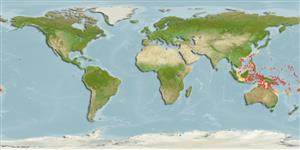>
Gobiiformes (Gobies) >
Gobiidae (Gobies) > Gobiinae
Etymology: Trimma: Greek, trimma, -atos = something crushed (Ref. 45335); nasa: Name derived from the English word 'nasal', a bar descending gtom the front of many medieval helmets to protect the nose, in allusion to the snout stripe; noun in apposition..
More on author: Winterbottom.
Environment: milieu / climate zone / depth range / distribution range
Ecologia
marino demersale; distribuzione batimetrica 0 - 41 m (Ref. 55345), usually 0 - 20 m (Ref. 55345). Tropical
Western Pacific: Solomon Islands, Papua New Guinea, Indonesia, Vanuatu, Fiji, New Caledonia, Australia, the Philippines, and Palau.
Size / Peso / Age
Maturity: Lm ? range ? - ? cm
Max length : 2.3 cm SL maschio/sesso non determinato; (Ref. 55345); 2.0 cm SL (female)
Spine dorsali (totale): 7; Raggi dorsali molli (totale): 8; Spine anali 1; Raggi anali molli: 7 - 9. Diagnosis: Predorsal scales and a bony interorbital about pupil diameter in width. Second dorsal spine elongated. Fifth pelvic fin ray branched dichotomously once and 50-60% of the fourth. Scales on cheek absent; one or two scales on the upper opercle; usually 4-5 rows of scales anterior to the pelvic fin base. A large spot over the hypural region of the caudal peduncle; a dark area along the side of the body caused by peritoneal pigmentation. In all specimens, but that from Palau and New Caledonia, there is a thin, dark stripe from the upper lip to the mid region of the interorbital when preserved (white in life), a broad rounded ridge on the snout and anterior interorbital region, and a nasal sac with a tubular anterior opening and a pore-like posterior opening with a raised rim (Ref. 55345); characterized further by having longitudinal scale series 23-24; predorsal scales 5-7; depth of body 4.3-4.6 in SL (Ref. 90102).
Cryptobenthic, epibenthic. Collected on drop-offs, either sloping or vertical with caves. Apparently tends to congregate in loose schools close to the shelter of caves and sea fans, to which they retreat when approached, and seem to be most abundant at about 20 meter depth range. Often form mixed schools with Trimma tevegae (Ref. 55345).
Life cycle and mating behavior
Maturità | Riproduzione | Deposizione | Uova | Fecundity | Larve
Winterbottom, R., 2005. Two new species of the Trimma tevegae species group from the Western Pacific (Percomorpha: Gobiidae). aqua, J. Ichthyol. Aquat. Biol. 10(1):29-38. (Ref. 55345)
IUCN Red List Status (Ref. 130435)
Threat to humans
Harmless
Human uses
Informazioni ulteriori
Nomi ComuniSinonimiMetabolismoPredatoriEcotossicologiaRiproduzioneMaturitàDeposizioneSpawning aggregationFecundityUovaEgg development
BibliografiaAcquacolturaProfilo di acquacolturaVarietàGeneticaElectrophoresesEreditarietàMalattieElaborazioneNutrientsMass conversion
CollaboratoriImmaginiStamps, Coins Misc.SuoniCiguateraVelocitàModalità di nuotoArea branchialeOtolithsCervelliVista
Strumenti
Special reports
Download XML
Fonti Internet
Estimates based on models
Preferred temperature (Ref.
123201): 26.5 - 29.1, mean 28 °C (based on 330 cells).
Phylogenetic diversity index (Ref.
82804): PD
50 = 0.5000 [Uniqueness, from 0.5 = low to 2.0 = high].
Bayesian length-weight: a=0.01023 (0.00477 - 0.02194), b=3.02 (2.84 - 3.20), in cm total length, based on LWR estimates for this (Sub)family-body shape (Ref.
93245).
Resilienza (Ref.
120179): Alto, tempo minimo di raddoppiamento della popolazione meno di 15 mesi (Preliminary K or Fecundity.).
Fishing Vulnerability (Ref.
59153): Low vulnerability (10 of 100).
